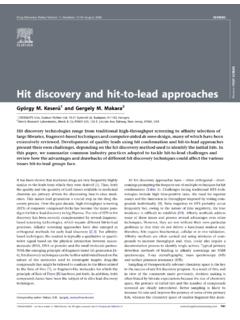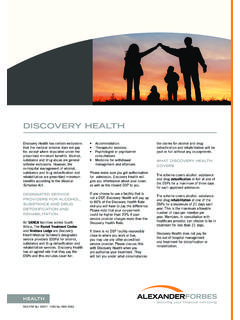Transcription of 21-37-20082015 COMPUTATIONAL DRUG RE …
1 International Journal of Latest Research in Science and Technology ISSN (Online):2278-5299 Volume 4, Issue 4: Page , July-August 2015 ISSN:2278-5299 119 COMPUTATIONAL drug RE-POSITIONING: AN APPROACH TO DISCOVER NOVEL ANTIMALARIALS 1 Yunusa, Abdulmajeed;1,2 Bello, shaibu Oricha;1 Chika, Aminu 1 Department of Pharmacology and Therapeutics, College of Health Sciences, Usmanu Danfodiyo University Sokoto, Nigeria, PMB 2346 2 Karaye Hospital, Emir Yahaya Road, Sokoto, Nigeria. Abstract- In this study molecular docking method was used to select potential inhibitors of the Plasmodium targets and the antimalarial activity of these inhibitors (drugs) was confirmed using Plasmodium berghei induced mice (in vivo). One hundred commercially available drugs not used for malaria were selected from DrugBank and the potential binding affinities of the selected drugs against the Plasmodium targets were analysed using molegro virtual docker software.
2 Ten drugs with the best affinities (Fluconazole, indomethacin, loratidine, lisinopril, meloxicam, promethazine, nifedipine, clarithromycin, piroxicam and flucloxacillin) were selected and the antimalarial activity of these drugs were confirmed using Plasmodium berghei mice model. Nifedipine, clarithromycin, flucloxacillin and lisinopril produced significant suppressive, curative and prophylactic activity while meloxicam and piroxicam produced only significant suppressive and curative activity. All the tested drugs produced significant suppressive activity. Nifedipine, clarithromycin, flucloxacillin and lisinopril are therefore potential chemoprophylatic and chemothrerapeutic agents whilemeloxicam and piroxicam are potential chemotherapeutic agents. Keywords- Plasmodium berghei, Antimalarial, COMPUTATIONAL repositioning;Mice. I. INTRODUCTION Malaria is a major public health problem in Nigeria affecting more than 100 million people annually(1).
3 In 2010, about 216 million people were infected with 655,000 mortality worldwide. African region accounts for 81% and 91% of the cases and deaths respectively, with 86% of the mortalities observed among theunder-fives. Nigeria, Cote d Ivoire, the democratic republic of Congo, Mozambique, Burkina Faso and Mali accounted for 60% of malaria deaths in 2010(1)The emergence of drug -resistant strains has compromised the efficacy of several antimalarial drugs, including artemisinin, thus necessitating the need for discovering of other novel antimalarial(2).Repositioning of known drugs for a new therapeutic use can be employed alternatively to the traditional/conventional process of drug development. The conventional process of drug development requires identification and optimization of a lead compound, preclinical studies and clinical trials, hence time-consuming and very expensive(3). An average expenditure for developing a new drug totaling to 400 million dollars with an average duration of 17-20 years(4).
4 An alternative to the traditional/conventional process of drug development is repositioning of known drugs for a new therapeutic use. This is cost-effective and time-efficient; therefore, many pharmaceutical companies are currently moving from de-novo drug discovery to repositioning of known drugs for a new therapeutic use. The estimated time required for repositioning of a known drug for a new clinical indication is 3-12 years (5). There are several examples of such successful repositioning of drugs. For example, Thalidomide, a drug released into the market in 1957 for treatment of morning sickness but later withdrawn in 1961 due to its teratogenic effect has been repositioned for use in erythema nodosum leprosum and multiple myeloma (5). Another well-known example is sildenefil, a phosphodiesterase inhibitor, initially developed for managing angina, but later repositioned for erectile dysfunction (5). Others include the antihypertensive agent minoxidil, currently approved for male baldness (5), the anti-cancer agent raloxifene was later repositioned for use in osteoporosis (5), the antiretroviral drug plerixafor subsequently repositioned for multiple myeloma and tretinoin, an anti-acne drug that was later developed for acute promyelocytic leukaemia(APL) (5).
5 Nsanzabana and Rosenthal (6)demostrated synergism of HIV Aspartate protease inhibitor, lopinavir with lumefantrine against P. falciparum invitro. COMPUTATIONAL drug repositioning using molecular docking method can be employed to develop a virtual screening platform to predict binding affinities between a library of known therapeutic agents and the protein targets(5) Molecular docking remains the principal COMPUTATIONAL technique widely adopted in drug discovery (3). It is a structure based virtual screening that predict the binding orientation and binding affinity of a small molecule (potential drug ) and a protein target (3). This technique was pioneered in early 1960(s) and remains the generally acceptable method in drug discovery. The rapid rise in the number of the known id950155 pdfMachine by Broadgun Software - a great PDF writer! - a great PDF creator! - International Journal of Latest Research in Science and Technology.
6 ISSN:2278-5299 120 three dimensional structures of Plasmodium falciparum protein targets through X-ray crystallography has made structure based virtual screening more prominent in drug discovery (3). The advantage of molecular docking virtualscreening over the traditional experimental method is that it saves time and resources(3) In a study by, COMPUTATIONAL drug repositioning has been attempted by many researchers. For instance, Li, An (7) employed the approachto identify nilotinib as a potent inhibitor of MAPK14 drug target (a protein responsible for inflammation) and Penna-Coutinho, Cortopassi (8) used the method to select three (3) drugs with best affinity for Plasmodium falciparumlactate dehydrogenase (PfLDH) and the antimalarial activity of the selected drugs were then confirmed using Plasmodium berghei mice model.
7 Is it possible to use COMPUTATIONAL method to discover known drugs (not used for malaria) with activity against multiplePlasmodium targets? This question is examined in the current study. Abbreviations: PDB, Protein data bank; NCBI, National center for biotechnology information; MVD, Molegro virtual docker; MST, Mean survival time. II. MATERIALS AND METHODS 1) A. Development of local data base of molecular targets in Plasmodium from PDB (Protein data bank) The three dimensional structure of ten (10) important Plasmodium targets (in PDB text format) necessary for its survival and multiplication were selected and downloaded from the protein data bank(PDB) website ( ) and a local data base was created for the plasmodium targets in a personal computer. 2) B. Criteria for target selection The Plasmodium protein targets were selected based on validated selection criteria and scoring. Targets with score of at least 80 out of 115 were selected and considered critical in the survival and multiplication of the parasite.
8 The criteria include: involvement in a critical pathway necessary for the survival and replication of plasmodium, confirmed or putativetargets of known antimalarial,absenceof significant cross talk from National center for biotechnology information(NCBI) blast search, drugability of the target (easily accessible binding site) and site or location of the protein target within parasite (membrane/cytoplasm). 3) C. Development of local data base of the potential ligands from DrugBank One hundred (100) commercially available drugs, used for indications other than malaria, were three dimensional structures of the drugs were downloaded from DrugBank website ( ) and saved in SDF format. A local data base for the downloaded drugs was created in a personal computer. 4) D. Criteria for drug selection Drugs with excellent safety profile (LD50>2000mg/kg), easily available (out of patent), inexpensive, with no reported pharmacokinetic interaction with any known antimalarial were selected for the work.
9 5) E. Insilico docking and selection ofbestten (10) drugs Docking simulation of the drugs against the Plasmodium targets was ran using molegro virtual docker version (CLC Bio in Denmark).It start with identification of binding sites of the protein targets. Molegro virtual docker (MVD) was used topredict various orientations or conformations of the drugs against the protein targets. The conformations with the least binding energies were selected and saved. The average binding energies was calculated for each ligand after ten simulations with MVD. A protein fixed and ligand flexible docking methodcalled Lamarkian genetic algorithm was employed. The Hydrogen bond score, Number of Hydrogenbond and interacting residues of the protein with the ligands were also analysed using the software. Ten(10) best drugs with the least binding energies against the Plasmodium targets were selected for confirmation of activity in the wet laboratory using Plasmodium berghei mice model (in vivo).
10 6) F. Experimental Animals Six to eight weeks-old male albino mice (20 8g) obtained from the animal house of Institute for Advanced Medical Research and Training (IMRAT) university college hospital Ibadan, Nigeria were used for this study. The animals were housed in cages with free access to water and food pellets and allowed to adapt for a week before commencement of the study. The animals were maintained at a temperature 22 1oC,relative humidity of 14 1% and under 12 hour light and 12 hour dark cycle. The experiment was performed in accordance with the guidelines of university committee on the use and care of animals. 7) G. Plasmodium berghei parasite The NK65 chloroquine sensitivestrain of Plasmodium bergheiwas purchased from National Institute for Pharmaceutical Research and Development (NIPRD), Idu, Abuja, Nigeria. The parasite was conserved in the Department of pharmacology laboratory, Usmanu Danfodiyo University Sokoto via passage of blood from infected into healthy mice.





